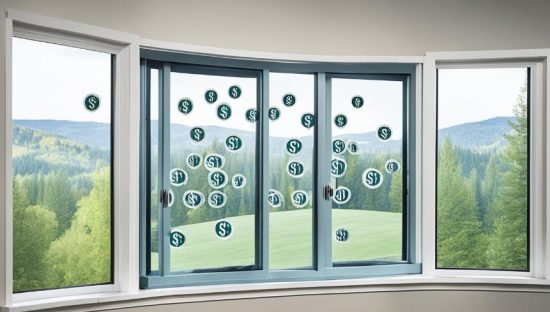Do you often find yourself struggling to sleep due to external noise? Are you tired of being disturbed by the sounds of traffic or your noisy neighbors? Soundproofing your windows might be the solution you’ve been searching for.
Noise pollution can have a significant impact on the comfort and tranquility of your home. Fortunately, by implementing effective soundproofing measures, you can create a quieter living environment and reduce noise pollution in your home. So, are you ready to say goodbye to unwanted noise and embrace a newfound sense of calm and relaxation? Let’s know more about how to soundproof windows and tips that will transform your windows into a barrier against noise pollution.
Why We Have to Soundproof Windows?
Soundproofing windows is essential for creating a peaceful living space by reducing external noise pollution and improving sleep quality. Especially in bedroom layout ideas, window soundproof is the first thing to check. It can help lower stress levels, enhance concentration, and create a calmer atmosphere. By minimizing distractions and promoting relaxation, soundproof windows contribute to a higher quality of life and improved well-being overall.
The Cost-Benefit Analysis of Soundproofing Your Windows
Before embarking on a soundproofing project, it is important to consider the financial aspects. Understanding the cost of soundproofing windows and its potential long-term savings can help you make an informed decision.
Initial Investment vs. Long-Term Savings
When it comes to soundproofing windows, there is an initial investment involved. This includes the cost of materials, professional assistance (if required), and your time and effort. However, it is essential to look beyond the immediate expenses and consider the long-term savings.
By soundproofing your windows, you can significantly reduce noise pollution in your home, enhancing your comfort and quality of life. This can have a positive impact on your well-being, sleep quality, concentration, and overall productivity. Additionally, a quieter living environment may contribute to lower stress levels and improved mental health.
Furthermore, soundproof windows can also offer thermal insulation, helping to regulate indoor temperature and reduce energy consumption. This can lead to potential savings on heating and cooling costs, ultimately providing a return on your initial investment.
Estimating Your Soundproofing Budget
Estimating the cost of soundproofing windows depends on factors like size, number of windows, chosen solutions, and need for professional help. Costs can range from $200 to $1,000 per window, with additional expenses for materials and tools. Researching options and getting quotes can help create a realistic budget. Despite upfront costs, soundproofing is a worthwhile investment for long-term benefits, including a peaceful environment and potential energy savings.
Types of Noise Pollution and How Windows Can Help

Noise pollution can have a significant impact on our daily lives, affecting our sleep, concentration, and overall well-being. Understanding the different types of noise pollution and their sources is crucial when it comes to effectively soundproofing your windows. In this section, we will explore various types of noise pollution and discuss how windows can help mitigate their effects in your living space.
Air Traffic Noise Mitigation
Air traffic noise can be a major issue for those living near airports or flight paths. The constant sound of jet engines can disturb the peace and quiet of your home. However, windows can play a crucial role in reducing air traffic noise. Double-pane windows with insulating properties act as a barrier, limiting the transmission of sound waves into your living space. Additionally, soundproof curtains or blinds can further dampen noise levels by absorbing and blocking sound waves.
Quieting Down Road Traffic Sounds
Road traffic noise is a common source of noise pollution, especially for those living near busy streets or highways. Fortunately, windows can help mitigate the impact of road traffic noise. When choosing windows for noise reduction, look for ones with a high Sound Transmission Class (STC) rating. STC measures the ability of a window to block sound waves, with higher ratings indicating better sound isolation. Installing soundproofing seals and weatherstripping around windows can also help reduce noise infiltration.
Strategies for Counteracting Anti-Social Noise
Anti-social noise refers to noise generated by neighbors, construction sites, or other human activities. Dealing with anti-social noise can be challenging, but windows can offer some relief. Soundproofing measures such as double-glazed windows can significantly reduce the impact of noise from neighboring properties. Additionally, using specific window treatments like soundproof curtains or blinds can provide additional sound absorption and help create a more peaceful environment.
Reducing Rail and Tube Noise through Window Treatments
Rail and tube noise can be a concern for those living near train tracks or subway lines. The vibrations and rumbling caused by passing trains can penetrate through windows, leading to noise pollution. However, windows can be optimized to reduce the impact of rail and tube noise. Installing laminated glass windows can help absorb and block the sound waves, providing a quieter living space. You can also consider adding window treatments such as acoustic curtains or blinds to further enhance noise reduction.
The 8 Tips: How to Soundproof Windows

1. Seal gaps using acoustic caulk
Gaps around windows can be a significant source of noise infiltration. These gaps allow sound waves to easily pass through, diminishing the effectiveness of any other soundproofing measures you may have implemented. Therefore, it is crucial to seal these gaps to achieve maximum soundproofing.
One effective method for sealing gaps in windows is to use acoustic caulk. Acoustic caulk is specifically designed for noise reduction and provides an airtight seal that prevents sound from entering or escaping through the gaps.
To seal the gaps using acoustic caulk, follow these simple steps:
- Clean the window frame and remove any dirt or debris that may interfere with the adhesion of the caulk.
- Using a caulk gun, apply a generous amount of acoustic caulk along the gaps between the window frame and the wall. Make sure to fill the gaps completely.
- Smooth the caulk using a caulk smoothing tool or your finger to create a neat and even seal.
- Allow the caulk to dry completely according to the manufacturer’s instructions.
By sealing the gaps with acoustic caulk, you can effectively reduce the sound transmission through the windows and significantly improve the soundproofing of your living space.
2. Apply weatherstripping tape to the window frame
Weatherstripping is an effective method for soundproofing windows and reducing noise infiltration. One of the key areas where sound can enter or escape your home is through gaps around the window frame. Applying weatherstripping tape to the window frame can help seal these gaps, preventing sound from passing through and improving the insulation of your windows. Additionally, weatherstripping tape can also help enhance energy efficiency by reducing drafts and heat loss.
To apply weatherstripping tape to the window frame, follow these steps:
- Clean the window frame thoroughly to ensure proper adhesion.
- Measure the length of each side of the window frame and cut the weatherstripping tape accordingly.
- Peel off the backing of the weatherstripping tape and carefully apply it along the perimeter of the window frame, making sure to press it firmly against the surface.
- Repeat the process for each side of the window frame.
- Inspect the weatherstripping tape to ensure it is securely attached and fills any gaps or cracks.
- Trim any excess weatherstripping tape for a neat and professional finish.
3. Rearrange furniture for noise absorption
The arrangement of furniture in your home can play a crucial role in minimizing noise and creating a more peaceful environment. By strategically positioning your furniture, you can optimize sound absorption and reduce noise transmission.
Here are some tips to help you optimize your room layout for soundproofing:
- Use dense materials: Place furniture pieces that are made of dense materials, such as wood or upholstered pieces, against walls or in areas where noise enters your space.
- Create barriers: Position bookcases, shelves, or other furniture pieces that have open backs near windows or walls to create a barrier that can help block sound waves.
- Arrange in layers: Create layers of furniture by positioning taller pieces, such as cabinets or shelves, in front of windows or walls to further disrupt sound transmission.
- Utilize soft materials: Incorporate soft materials, such as curtains or rugs, to absorb sound waves and reduce echo in the room.
- Optimize seating placement: Position seating areas away from windows or noisy areas to minimize the direct impact of external noise.
- Consider room dividers: If your space allows, use room dividers or screens to create separate zones and provide additional sound insulation.
By strategically arranging your furniture, you can enhance sound absorption and create a quieter and more peaceful living environment.
4. Use soundproof blankets over windows
Soundproof blankets or curtains are highly effective in reducing noise transmission through windows. Made with dense, sound-absorbing materials like mass-loaded vinyl and fiberglass, they block external noise from entering your home. These blankets are versatile, easily installed over windows, curtains, or blinds, and can be reused as needed. When choosing soundproof blankets, consider the level of noise reduction required and measure your windows accurately for a proper fit. Follow the manufacturer’s instructions for installation to ensure maximum effectiveness in reducing noise. Overall, soundproof blankets offer a practical and convenient solution for creating a quieter and more peaceful living environment.

5. Apply vinyl film for noise reduction
Another solution for soundproofing windows is the application of vinyl film. Vinyl film is a transparent and cost-effective option that can effectively reduce noise transmission while maintaining natural light and visibility in your home.
To apply the vinyl film to your windows and reap its soundproofing benefits, follow these step-by-step instructions:
- Clean the window thoroughly to ensure a smooth surface for the film.
- Measure the window dimensions and cut the vinyl film to fit.
- Peel off the backing of the film to reveal the adhesive side.
- Carefully apply the film to the window, starting from one corner and smoothing it out as you go.
- Use a squeegee or a credit card to remove any air bubbles and ensure a secure adhesion.
- Trim any excess film, if necessary.
By applying vinyl film to your windows, you can achieve effective noise reduction without compromising the aesthetics of your living space. Enjoy a quieter and more peaceful environment in your home with this transparent soundproofing solution.
6. Install interior window inserts for soundproofing
Interior window inserts, or secondary window glazing, are custom panels that fit inside existing windows, creating an air pocket that reduces noise and heat transfer. They enhance soundproofing, making your home quieter and more peaceful by reducing noise from outside sources. Additionally, these inserts provide insulation, reducing drafts and improving energy efficiency, potentially lowering heating and cooling costs. They are versatile, easy to install and remove, and come in various materials such as acrylic, polycarbonate, laminated glass, or low-E coatings, each with its own benefits. Consulting with a professional can help you choose the right inserts for your windows, improving your indoor environment’s comfort and tranquility.
7. Create an outdoor sound barrier
Creating an outdoor sound barrier is an effective way to enhance the noise reduction efforts you’ve made inside your home. By incorporating outdoor sound barriers, you can create a peaceful and quiet environment in your outdoor spaces.
Here are some tips and techniques for creating an effective outdoor sound barrier:
- Landscaping: Utilize dense shrubs, trees, and plants to absorb and block noise. Planting a row of tall evergreen trees or installing a dense hedge can help reduce noise pollution.
- Fences and Walls: Constructing a solid fence or wall can help block the transmission of sound. Opt for materials that are dense and have good acoustic qualities for maximum effectiveness.
- Water Features: Incorporate water elements, such as fountains or waterfalls, into your outdoor space. The sound of flowing water can help mask unwanted noises and create a soothing atmosphere.
- Outdoor Structures: Consider adding pergolas, gazebos, or outdoor pavilions to create physical barriers that can deflect and absorb sound waves.
8. Upgrade to double-pane windows
When it comes to improving the soundproofing capabilities of your windows, upgrading to double-pane windows is a wise investment. These windows offer a range of benefits, including enhanced insulation, reduced noise transmission, and increased energy efficiency.
Double-pane windows consist of two layers of glass with a space in between, which acts as a barrier to sound waves. This design significantly reduces external noise, making your living space more peaceful and quiet. Whether you live in a bustling city or near a busy road, double-pane windows can help create a serene environment for you and your family.
Not only do double-pane windows enhance soundproofing, but they also improve energy efficiency. The insulation properties of these windows help to keep your home cooler in the summer and warmer in the winter. By reducing heat transfer through the windows, double-pane windows can contribute to lower energy bills and a more comfortable indoor climate.
When considering an upgrade to double-pane windows, it’s important to choose insulated windows that are specifically designed for soundproofing. Many reputable brands, such as Andersen and Pella, offer double-pane windows with additional features like laminated glass or gas fills between the glass layers to further enhance noise reduction.
FAQs on Window Soundproofing
How do I estimate my soundproofing budget?
To estimate your soundproofing budget, you should consider factors such as the size and number of windows, the chosen soundproofing solutions, and any professional assistance required. It is important to assess the initial investment required and potential long-term savings.
What types of noise pollution can windows help mitigate?
Windows can help mitigate various types of noise pollution, including air traffic, road traffic, anti-social noise, and rail/tube noise. There are strategies and window treatments available to reduce the impact of each type of noise on your living space.
How does vinyl film help with soundproofing windows?
Vinyl film is a transparent and cost-effective solution for soundproofing windows. It reduces noise transmission while maintaining natural light and visibility. Applying vinyl film to windows can significantly reduce noise infiltration.

